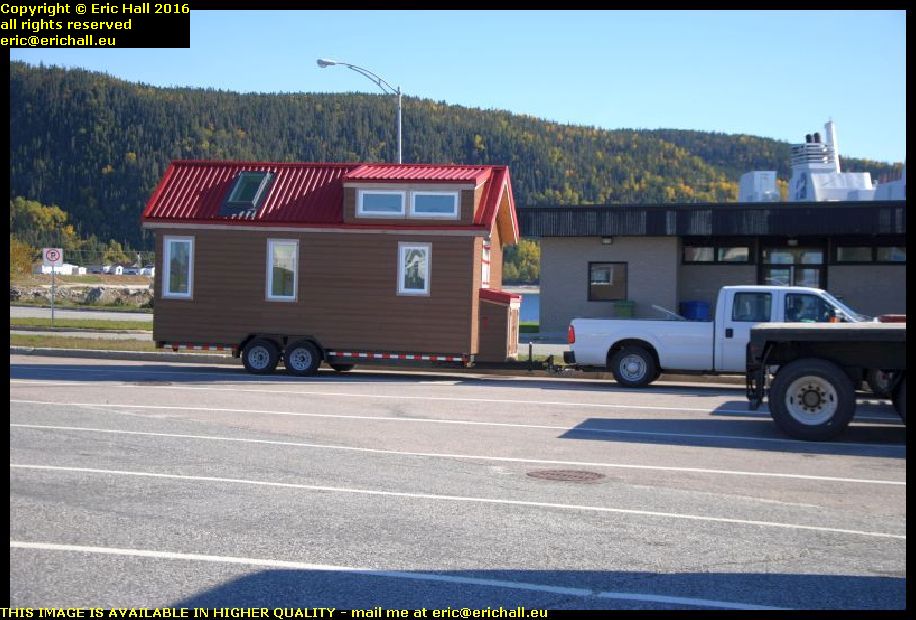 … about this journey on the train taking for ever.
… about this journey on the train taking for ever.
As dawn broke and the sun began to lighten up the sky we on board the train are slowly climbing up past Lake Matapedia.
According to the times of this and the previous photograph that I took as we were leaving Montreal in the dusk, we’ve been travelling for just over 11 hours and have covered a distance of about 620 kilometres.
That’s an average speed of just over 56 kilometres per hour, or 35 mph.
Had I been travelling on a long-distance train covering this distance in Mainland Europe, it would have taken about 2.5 hours. It just goes to show how primitive rail travel is over here in North America.
Despite being very uncomfortable last night curled up in my chair, I did manage actually to go to sleep for at least part of the night. That much is evidenced by the stuff that’s on the dictaphone. I can’t remember very much about this first bit but there were some people who were moving house. We entered a lift, a group of us, and they came in behind with a lorry. While the lift was going up they wee busy cleaning a pile of dust out of the filters of this lorry and choking all of us at the back with the dust. I shouted at them to stop only to find that I didn’t have a voice. My voice had gone and I couldn’t make myself heard at all so I approached a little closer but still couldn’t make myself heard. My voice had gone and there was no possibility of expressing myself while we were being choked by this dust that was being cleared out of this filter
And later on I was with Nerina. We were remodelling the kitchen at the Place d’Armes. She decided that instead of the lino she wanted a different kind of floor so she was measuring. It meant moving out the furniture. One of the cupboards was absolutely disgusting. It hadn’t been cleaned for years. It was awful and I said that we would probably need a new cupboard to replace it. She said “let’s not worry about that for now. Let’s do this floor”. She was measuring it and making a list of what she wanted. In the meantime we’d made some vegan hamburgers on bread but they hadn’t turned out very well at all because the hamburger press that we had was not very good. One of Nerina’s friends was there with her husband. He had the idea of needing the hamburger press to put the hamburger press on its bun and then hitting the hamburger press with a hammer. He said that a mallet was what was needed but he couldn’t find one just then but hitting it with a hammer seemed to cut the teeth of the hamburger press through the bread as well as through the hamburger meat and was making these nice hamburgers. They thought that that was really impressive to hit it with a hammer
 As we climbed into the Matapedia Valley the day gradually lightened and I took several photos of the landscape.
As we climbed into the Matapedia Valley the day gradually lightened and I took several photos of the landscape.
Many of them didn’t come out very well, what with the poor light. This was one of the better ones
The movement of the train didn’t help. It wasn’t very steady and we were swaying about considerably. And having seen at various times in the past the miserable state of the track, that’s not a surprise. It’ll probably explain the depressing speed of the train as well.
The state of the locomotives and carriages leaves a lot to be desired as well. Canada’s lack of commitment to an efficient, reliable, comfortable and rapid public transport system is quite an embarrassment for a developed country
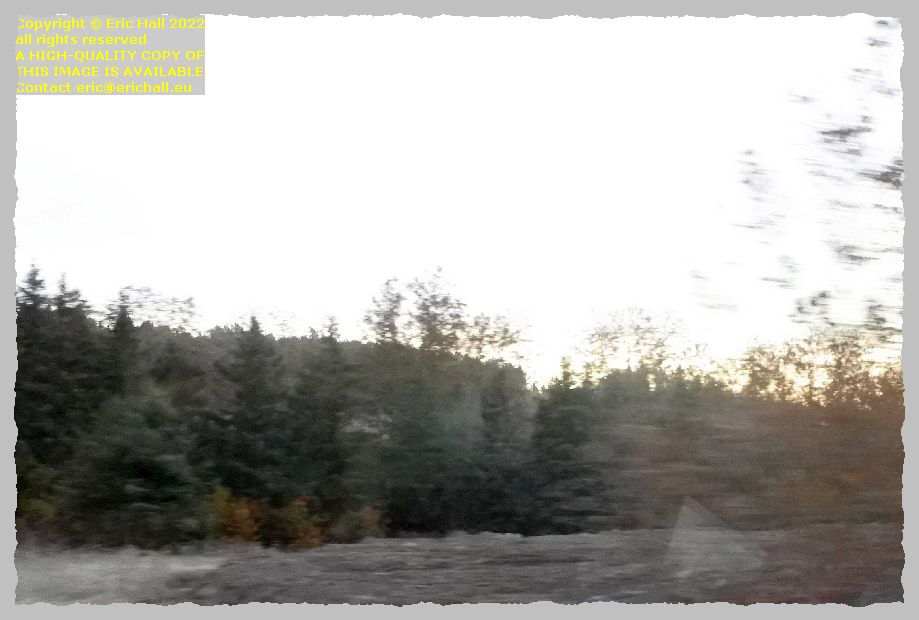 It’s slowly becoming lighter and lighter as we push on alongside the Matapedia River. The sun is rising slowly up above the horizon.
It’s slowly becoming lighter and lighter as we push on alongside the Matapedia River. The sun is rising slowly up above the horizon.
Our train is now slowly heading down the river valley that cleaves through the Appalachian Mountains and towards the Baie des Chaleurs and the border with New Brunswick.
Even though we’ll soon be in New Brunswick we still have a long way to go before we arrive in Moncton, and I have a long way to go after that before I arrive at my final destination
The Matapedia River valley was an old route de portage used by the courreurs de bois travelling between Nouvelle France and Acadie, and a long time before that by the mi’kmaq people.
 There are plenty of settlements alongside the shores of the river and the river would have been an important freight artery before the arrival of the railway and the road.
There are plenty of settlements alongside the shores of the river and the river would have been an important freight artery before the arrival of the railway and the road.
This here at the side of the road in the town of Matapedia looks as if it might have once been some kind of barge. However it was probably built much-more recently than those days.
It doesn’t look as if it will ever go back into the water though, even if it might once have come out of it.
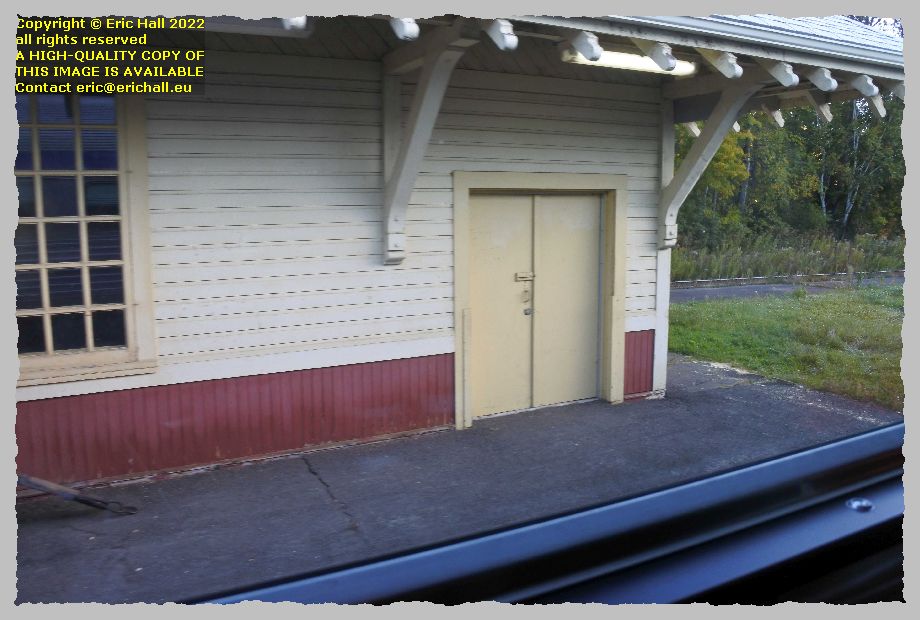 The town, such as it is, of Matapedia is also listed as being one of the stops on the railway line between Montreal and Halifax.
The town, such as it is, of Matapedia is also listed as being one of the stops on the railway line between Montreal and Halifax.
There is actually a railway station here but we didn’t stop long enough to alight to take a photograph. Never mind though, because I’ve photographed it when I’ve driven through here in the past and one day I’ll sort out my photos.
Ln the old days when passenger trains ran down the Gaspé Peninsula, this was the junction for the line. But those days are of course a long time ago. Regular readers of this rubbish will recall that on ONE OF OUR PREVIOUS VISITS TO GASPE we even found a complete train, locomotives, carriages and all, stranded at Gaspé station after they had cut the line in front of it.
Pulling out of the railway station we crossed over the Restigouche River, into which the Matapedia River has joined, into New Brunswick
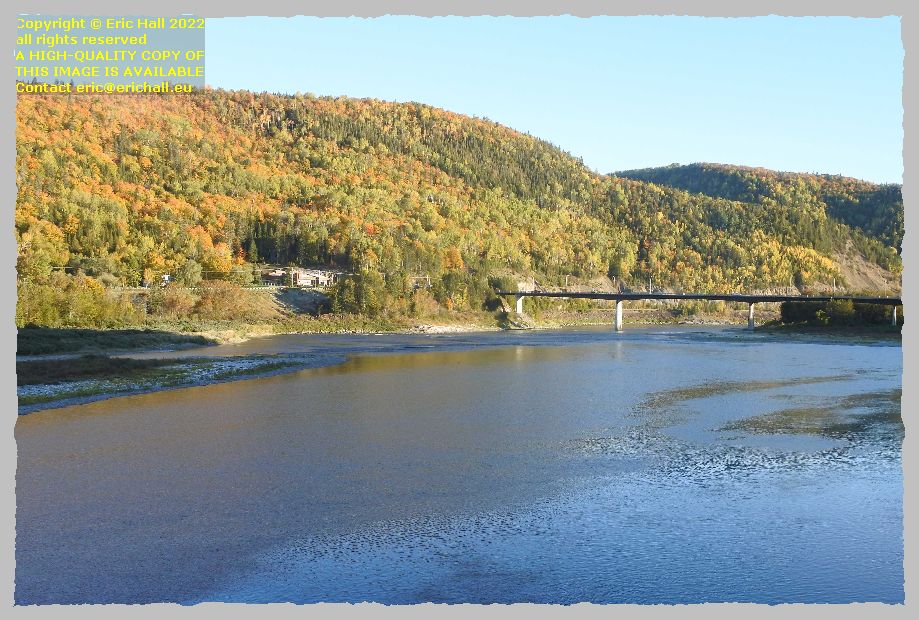 A little further on we catch a glimpse of the Matapedia Bridge, over which we have travelled by car along New Brunswick Highway 11 on many occasions in the past.
A little further on we catch a glimpse of the Matapedia Bridge, over which we have travelled by car along New Brunswick Highway 11 on many occasions in the past.
The bridge was built in 1974 and is 419 metres long. The border between the provinces is in the middle.
Talk about bridging the river around here seems to have begun in 1847 when a report was made on the state of the roads in the area, and there was certainly a bridge across here in the 1940s.
There are photos and postcards of that bridge and I’ve seen some of them, but I’ve not been able to find out much information about that one.
 In late morning we finally grind into the railway station at Campbellton where the train comes to a halt.
In late morning we finally grind into the railway station at Campbellton where the train comes to a halt.
From the train there’s a beautiful view of the Van Horne Bridge across the Restigouche River to the Gaspé Peninsula and the province of Québec.
It’s another bridge over which we’ve travelled on many occasions in the past.
Named for the New Brunswick Member of Parliament Joseph van Horne, it was built between 1958 and 1961 and is 805 metres long. Finance was provided by the Provinces of New Brunswick and Quebec and the Federal Government.
Previously there was a ferry across here as well as another ferry further downriver at Dalhousie, the remains of which WE HAVE VISITED IN THE PAST but by the 1950s they were totally inadequate to handle the volume of traffic that wanted to cross.
 We’re told that we’ll be stopped here for half an hour, presumably for a crew change and a refuelling, so we’re allowed to leave the train and go for a wander.
We’re told that we’ll be stopped here for half an hour, presumably for a crew change and a refuelling, so we’re allowed to leave the train and go for a wander.
Outside the station there’s a good view of Sugarloaf Mountain. We’ve seen this before on a couple of occasions when we’ve come this way by road in the past.
It’s actually a volcano, so I’m told, and is 922 feet high.
According to tradition, it’s actually a fossilised beaver. Glooscap, a legendary figure among the Mi’kmaq people, discovered a beaver blocking a river and so depriving the area’s inhabitants of their food supply so Glooscap plucked him out of the water and threw him onto land, and Sugarloaf Mountain is the beaver fossilised remains.
There are several interesting legends about Glooscap but there is one that especially intrigues me.
The native Americans recount a story about how Glooscap witnessed a group of people, strangers to the area, who were washed ashore with their damaged canoe somewhere on the coast of Nova Scotia.
The strangers then planted trees inside their canoe and then departed.
And if there’s a better description anywhere by native peoples of strangers repairing a damaged ship and erecting masts so that they can sail away, I’d love to see what it would be.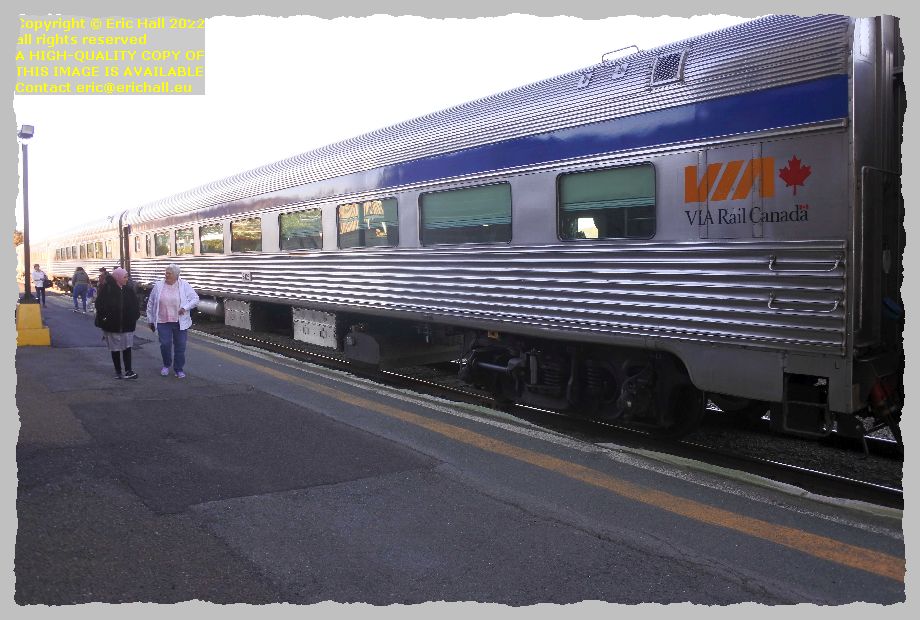 While I’m here I’ll go to have a look at my train.
While I’m here I’ll go to have a look at my train.
It’s just as well that I’m photographing it for posterity because it might not be here much longer. The frequency of trains is reducing year by year and it won’t be long, I reckon, before ViaRail cancels it completely.
Viarail complains that ridership is falling off and that it’s no longer economical to run it, but I do have to say that this is absolutely no surprise to me.
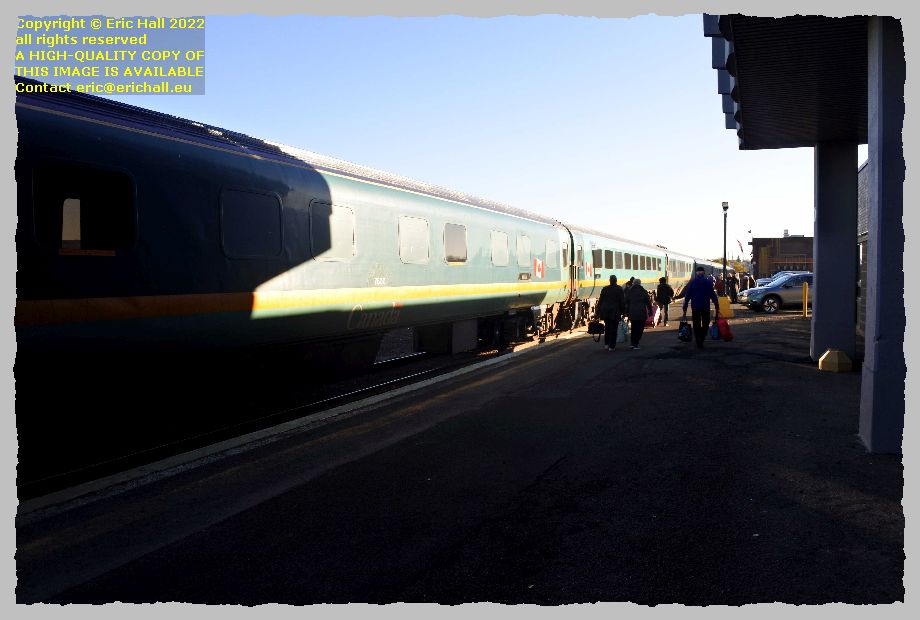 Quite frankly, this rail service is an embarrassment to a Developed Country such as Canada.
Quite frankly, this rail service is an embarrassment to a Developed Country such as Canada.
By my reckoning, we’ve travelled roughly 750 kilometres. The photo that I took on leaving Montreal was timed at 06:10 and on pulling into Campbellton it was 19:02. That’s roughly 13 hours.
In other words, the average speed to date is 57.5 kilometres per hour, or 36mph. And that is just a total disgrace.
In Europe we have probably 100 long-distance trains travelling at 300 kilometres per hour several times per day and on one occasion, when a driver was encouraged to give a train her head just to see what she could do, it was clocked at 574.4 kilometres per hour.
What’s happening in Canada is one of the oldest tricks in the book and those of us who live in Europe have seen it all a dozen times before.
The oil lobby buys up the politicians, the politicians refuse to invest in the railway network, the railway system falls apart, the passengers walk away. And then the oil lobby goes “there you are – we told you that no-one wants a railway network”.
This shambolic, primitive, embarrassing railway system that disgraces a nation is bleeding customers, but the high-speed trains in Europe are regularly sold out
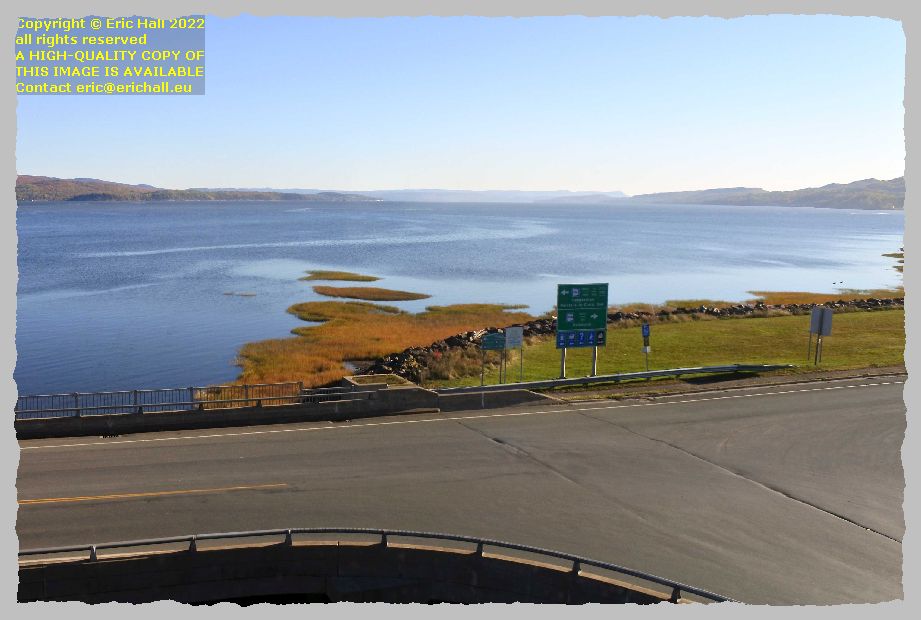 So abandoning another good rant for now, our train eventually pulls out of the station.
So abandoning another good rant for now, our train eventually pulls out of the station.
The next hour or so will see us running along the shores of the Baie des Chaleurs towards the Northunmberland strait that separates the mainland from Prince Edward Island
The bay was the scene of one of the most famous – or infamous (depending on whose side you are on) – sea battles that took place in 1760
 Despite what you might have learnt at school, Wolfe’s successful attack on Québec did not signify the end of French rule in North America.
Despite what you might have learnt at school, Wolfe’s successful attack on Québec did not signify the end of French rule in North America.
Montreal as well as much of the coast of Acadie, including the Baie des Chaleurs were still in French hands. In fact a French relief force sent to recapture the city of Québec had overwhelmed the British at the Battle of Sainte-Foy and pinned them down within the city walls.
The race was then on. Would the British fleet reach the city first, bringing relief to the besieged forces, or would the French fleet arrive first, bringing supplies and reinforcements to the besiegers?
In fact, it was the British fleet that arrived first. The captain of the French fleet decided to put into the Baie des Chaleurs in order to plan his next move and while he was there, to feed and arm the Acadian settlers.
In the meantime a British naval force had left LOUISBOURG in Nova Scotia on the train of the French ships and found them in the Bay.
Battle commenced on 27th July 1760 and over the next few days the British slowly pushed the French upriver and eventually, realising that there was no escape, the French scuttled two of their three ships and retreated to the shore.
The heavily-armed Acadians prevented the British from landing but the French maritime threat was ended. On 8th September 1760 Montreal surrendered and the Acadians surrendered on 28th October.
Since then, there have been several reported sightings of what is said to be a burning ghost ship, believed by many to be a phantom figure of one of the French ships and by others to relate to several other maritime incidents that took place in the bay back in the days of sail.
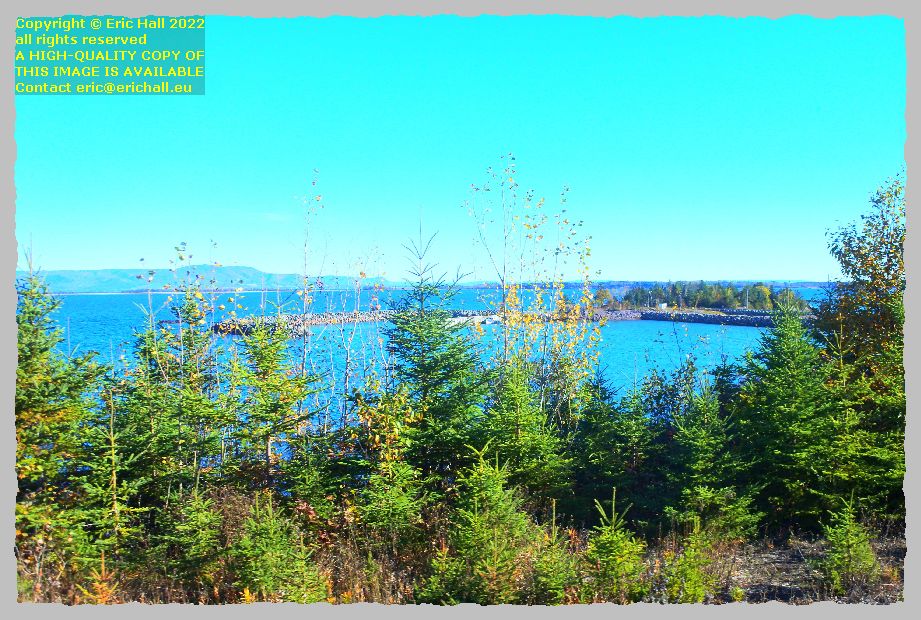 The Baie des Chaleurs is also the border between Québec and New Brunswick. To the north is Québec and we are in New Brunswick.
The Baie des Chaleurs is also the border between Québec and New Brunswick. To the north is Québec and we are in New Brunswick.
Nevertheless, the predominant language around here is French. As I hinted earlier on, we’re actually in what would have been known as “Acadie” in the 17th and 18th Centuries, named for the famous Arcadia of Greek legend and the et in Arcadia ego of the mysterious LEGEND OF RENNES-LE CHATEAU
What is today the province of New Brunswick was settled by the French but a whole series of wars with firstly the Dutch and secondly with the British (and in the past we’ve swarmed over the sites of several battles) resulted in the province being taken permanently by the British.
Much is made of the “expulsion of the Acadians” as hostilities finally drew to a close but accounts quite often omit the reason for the expulsion – namely that those expelled had refused to take an unconditional oath of loyalty to the British crown – and the situation is really no different than any other occupation of any other territory in the World by anyone else.
Don’t forget that 30 million Germans were forcibly expelled from their homes as recently as the period 1945-1948 without even being given the opportunity to take an oath of allegiance to the new Power occupying their lands.
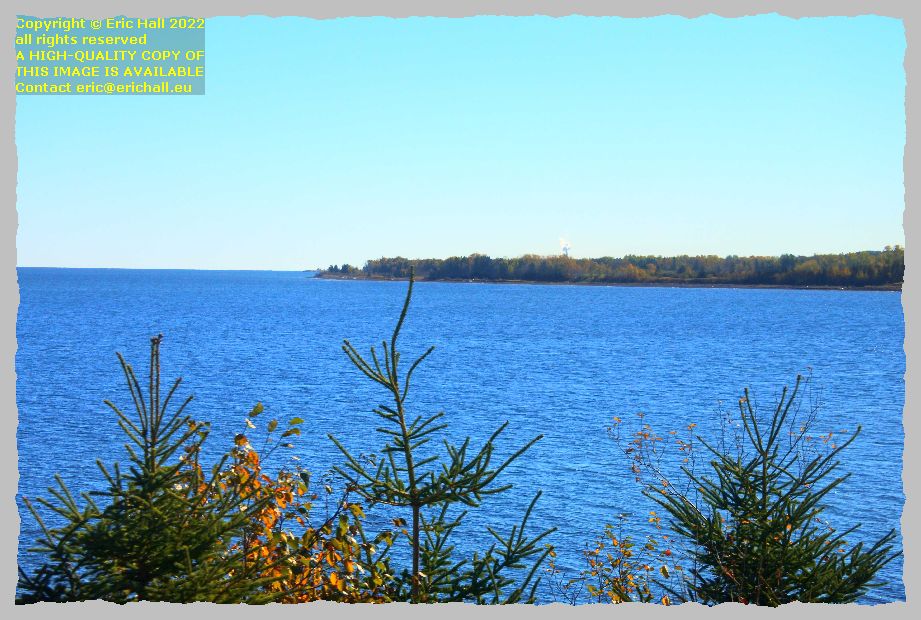 But returning to Acadie, the western part of New Brunswick is English-speaking, due in part (but not exclusively) to its occupation by “Empire Loyalists” who were expelled from their homes over across the border in the USA following the American War of Independence.
But returning to Acadie, the western part of New Brunswick is English-speaking, due in part (but not exclusively) to its occupation by “Empire Loyalists” who were expelled from their homes over across the border in the USA following the American War of Independence.
In 1784 the British colony of New Brunswick was created, distinct from that of Nova Scotia and in 1867 it became part of the Canadian Confederation, a decision regretted by many who feel much more empathy with the people of Maine and Vermont “over across” the border..
 You’ll read a great many stories about how New Brunswick was the poorest of the Canadian Provinces until recently, and while it is true in the literal sense, it’s rather misleading.
You’ll read a great many stories about how New Brunswick was the poorest of the Canadian Provinces until recently, and while it is true in the literal sense, it’s rather misleading.
The North-West Territories and Nunavut are territories, not Provinces and the Province of Newfoundland and Labrador was only admitted to the Confederation as recently as 1949.
If those areas were taken into account we’d see a completely different picture. Those areas are far poorer than New Brunswick
While we’ve been discussing the situation about New Brunswick we’ve been drifting down along the shore of Northumberland Strait and we’ve come into the town of Miramichi.
 After leaving the railway station we have to cross over the Miramichi River on the way south.
After leaving the railway station we have to cross over the Miramichi River on the way south.
Here just inland from the town the river branches into two arms. We are at the moment crossing over the northwest branch of the river.
It’s a shame that we can’t actually see the bridge because it’s a magnificent steel girder structure that was constructed in the early 1870s and was the first bridge to cross the Miramichi River
 After a brief rattle across a small strip of land we pass over the bridge that spans the southwest arm of the river.
After a brief rattle across a small strip of land we pass over the bridge that spans the southwest arm of the river.
Each of the two bridges consists of 3 spans, and the total combined length of the crossing is 2400 feet, a length that made it the second longest river crossing at the time, surpassed only by the Victoria Bridge across the St Lawrence at Montreal..
Rarely for the time, the bridges were built of iron instead of wood, which was much more usual back in those days. The Victoria Bridge, incidentally, was a metal bridge too.
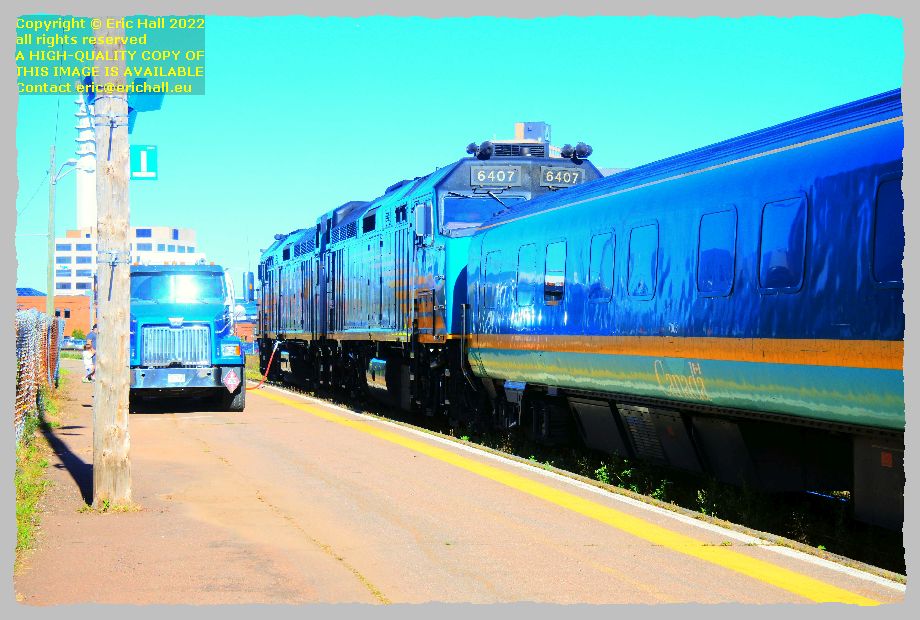 At long last our train finally staggers into Moncton Station where I’m going to be catching my bus northwards.
At long last our train finally staggers into Moncton Station where I’m going to be catching my bus northwards.
One of the two locomotives that is pulling the train is 6407, one of 52 EMD F40PH-2 locomotives currently operated by the company. I imagine that the one in front is a similar locomotive but because of the refuelling taking place, I wasn’t allowed any further forward than this so I couldn’t see which it is
As for 6407, it was involved in a fatal accident on 4th May 2010 when it hit a pick-up on a level crossing in Alberta and killed the 3 passengers of the vehicle.
These locomotives were introduced into service with effect from 1987 and that tells you everything you need to know about the shambolic state of affairs of this national embarrassment.
Even more embarrassing is that we left Montreal at about 06:00 (Central European Time) and pulled into Moncton at about 01:30 CET (time taken from photographs that I took.
That’s 19.5 hours on the train to travel a rough distance of 1095 kilometres, an average speed of 56 kilometres per hour or 35 mph, and despite the fact that there are about 1,030,000 words in the English language, that isn’t enough to express my thoughts on the issue.
For someone who is used to travelling on long-distance trains travelling at speeds of 300 kilometres per hour all that I can realistically say is that the Canadian Government and Viarail need to take a long, hard look at themselves in a mirror sometime.
Viarail complains about passengers deserting its network in droves, but this shambolic and embarrassing service with antediluvian equipment is a national humiliation that speaks for itself
But we’ve seen all of this before on many occasions and we know the reason for it too.
If you want to wash your hands of something, you refuse to invest in it, run it into the ground, it all goes pear-shaped, the passengers desert the sinking ship and then you can say ‘there you are – we said that no-one wants it” and you can close it down with a clear conscience.
As I’ve said, we’ve seen all this before.
Actually the train journey was more comfortable than I had imagined. There was plenty of legroom and reclining seats made it much more comfortable than an aeroplane and I ended up not regretting my choice, apart of course from the time that it took. Having said that, I wouldn’t have liked to be have been screwed up in a budget aeroplane seat for half the amount of time that this journey took.
As for the railway food, I didn’t get to sample any of it. I had my jammy bagels and also a packet of my usual crackers.
There was a tea trolley that came round at regular intervals and the coffee was not as bad as it might have been. And surprisingly, seeing as we were talking about Ukrainians, there was a Ukrainian refugee and her small children on the train just in front of them so I offered them drinks. I bet she was surprised to hear someone talking Pidgin Russian on board the train. I really must improve my Russian.
 We’re actually late arriving in Moncton, which is apparently no surprise to anyone. In fact they considered that to be something of an achievement of which they felt proud. I wasn’t all that bothered because it meant less time to stand around at the terminal for my bus.
We’re actually late arriving in Moncton, which is apparently no surprise to anyone. In fact they considered that to be something of an achievement of which they felt proud. I wasn’t all that bothered because it meant less time to stand around at the terminal for my bus.
That means that my bus is already in and the driver is on his break. I can load my suitcase into the boot and then loiter around at my ease while I wait for things to happen.
The coach itself is a Prevost H3-45 built by a subsidiary of Volvo North America, one of 50 buses delivered this year to Maritime Bus for their operations, and they are quite comfortable.
This one is only 10 weeks old, and already with 50,000km on the clock. They like to work them hard.
 In the past I’ve travelled on many of these coaches but usually in the opposite direction.
In the past I’ve travelled on many of these coaches but usually in the opposite direction.
Before the Pandemic, I’d catch an “Orleans Express” coach from Montreal to Gaspé and alight at Rivière du Loup.
After a wait of about 90 minutes the Maritime Bus from Moncton would pull in and turn round, and I’d board it for its return trip and alight at Florenceville
When inter-provincial transport was cancelled at the start of the Pandemic, the Maritime Bus turned round at Edmundston, 120 kilometres away from Riviere du Loup across the border in New Brunswick and for reasons that only Maritime Bus will understand, the service across the border hasn’t been reinstated
There’s no passenger transport connection so what used to be a 7-hour coach trip has now turned into in an unbelievable 26-hour marathon that I wish that I didn’t have to do
There was time to discuss the situation about the buses with the driver. He seems to think that the issues with going north into Québec from Edmundston arise with Orleans Express who revised the schedule during the Covid lockdown when fewer people were travelling and now can’t – or won’t – reinstate it. And so the there’s an appropriate connection.
However there’s some good news. It appears that it’s a licensed service, the timing of the run from Québec City to Rivière-du-Loup that corresponds with the bus from Moncton to Rivière-du-Loup. It’s due for renewal in January and if it’s not actually operating, then the licence is forfeit. Coach Atlantic is well-aware of the potential here and the company will lodge a demand to take over the service if Orleans Express lets it fall by the wayside.
One bus all the way to Québec City opens up all kinds of new horizons, as long as the stop is actually at the main-line railway station and not at the outlying coach station at Sainte-Foy.
 So on the bus, I’m sitting comfortably and we set off north-west.
So on the bus, I’m sitting comfortably and we set off north-west.
We join the Trans Canada Highway at the big truckstop at Salisbury and a short while later, in between Jemseg and Corytown, we cross over the St John River.
We’ll be in Fredericton in a short while, so I reckon that we only have a couple of hours of my journey to go before I can find myself deep in the bosom of my family. And I can’t say that I’ll be sorry to stretch myself out I don’t think that I’ve ever been so uncomfortable in my whole life, what with one thing and another.
And once you find the first thing, you’d be surprised how many other things there are.
Our bus ended up being 25 minutes late arriving in Florenceville. There was an unscheduled stop at the airport as well as 2 coffee breaks that were a lot longer than the 10 minutes that he had announced.
My niece was waiting for me and it was lovely to see her after 3 years. Back here she made some food for me while we had a very long chat, and then I went to bed, totally wasted after my day of excitement.
Tomorrow I have to be up at … gulp … 05:45 for a Welsh lesson that starts at 06:00. I must be out of my mind.
